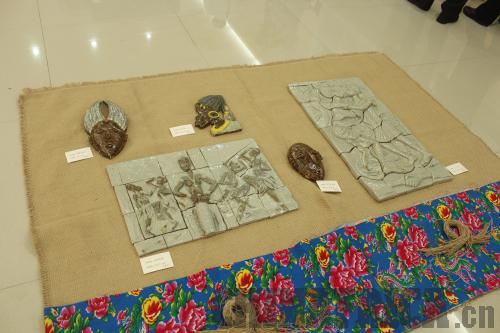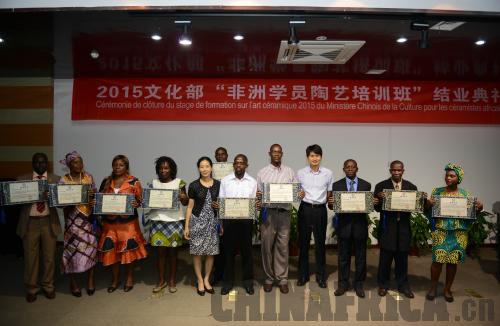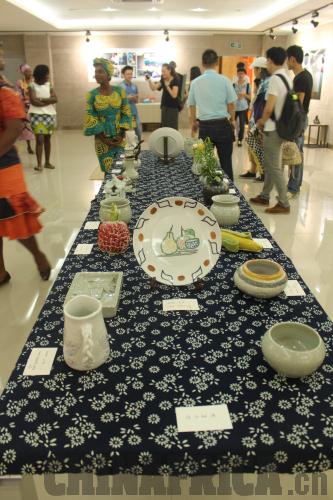| 

Closing ceremony of the ceramic training course organized for African participants by the Chinese Ministry of Culture
Creative Crossover
China's paradise city in the cultural spotlight
By Cui Xiaoqin
When the Zhejiang Cultural Center in Hangzhou, capital of Zhejiang Province in east China, hosted a week-long exhibition of ceramic pottery in July, there was something extraordinary about it. The pottery seemed to have some of the features of the porcelains that had made the Song Dynasty period (960-1279) an art connoisseur's delight with their vivid glaze and sensuous finish. At the same time, there was something exotic about them too. The conscious viewer could trace elements of African folk art in them.
How did pottery made in China come to have African motifs? Because they were made by 10 Africans who were trained to make ceramic pottery in China by Chinese maestros. The exhibition displayed the creations of artisans from Burundi, Gabon and the Republic of Congo (ROC). Their one and a half months' training was the result of the Beijing Action Plan (2013-15) drawn up at the Fifth Ministerial Conference of the Forum on China-Africa Cooperation (FOCAC).
The pottery session saw Chinese experts teaching the African group skills of a heritage art and its history. Porcelain art reached its peak in China during the Song Dynasty. There were five major kilns - Guan, Ge, Ru, Ding and Jun. The Guan Kiln's fame came partly from its exclusivity and fineness since it produced ware only for the use of the royal court. Besides history, the visitors were also told about the new directions and concepts in modern Chinese pottery.
Huang Yun, Director of the cultural center's Art Exchanges Center, said the center had worked with the Hangzhou Southern Song Guan Kiln Research Institute to bring the experts from the Ceramic Industry Association of Zhejiang to train the group.
Laurels for Chinese maestro
The visitors appreciated their teacher. Boniface Barinakandi, who came from Burundi, said though he had no prior training, the course made him skillful. He lauded trainer Li Yuening, a veteran of nearly four decades and declared an inheritor of the Southern Song Guan Kiln art by the government due to his skill.
"Li encouraged us, pointed out the problems in the process of making pottery and explained the reasons patiently and carefully so [that we could] find the solution," he said.
Christiane Anguezomo Abaga, who came from Gabon, had learnt to make pottery for a year back home but it was during her stay in China that she saw a clay molding machine for the first time. The machine, she said, improved her speed vastly since pottery is entirely handmade in Gabon, slowing down production.
She was also greatly impressed by traditional Chinese medicine. "While making pottery, some dust got into my eyes. Li found some traditional Chinese herbal medicine for me. I recovered in two days. It was amazing," she said.

Ceramic ware on display
When cultures blend
Robert Zola from the ROC could be called a ceramics pro as he had received professional training in France and Germany and worked as a teacher at the National School of Fine Arts in Brazzaville.
His creations included a vase - with chopsticks in it. As he explained to mystified visitors, it stood for his impression of Hangzhou: "I [saw] chopsticks there for the first time!"
Abel Omer Malonga, also from the same country, was already well-versed in making glazed ceramic pottery. Despite his experience, he was still eager to hone his skills. His exhibit integrated African design elements.
The visitors demonstrated their different personalities and ideas in their work, at the same time showing a fusion of African and Chinese cultures.
Power of art
Li Yuening, the maestro, lauded his students. "They are very smart and have strong practical ability as well as their own unique understanding of clay," he said. "They also helped one another during the training."
"Though they stayed in Zhejiang for a short time, their artistic talent and simplicity greatly impressed us," said Li Sha, Deputy Inspector of Culture Department of Zhejiang Province.
Besides attending the classes, the visitors were taken to the Hangzhou Museum and Southern Song Guan Kiln Museum to learn more about ceramics and other traditional Chinese crafts. A tour of Hangzhou's famed sites such as the beautiful West Lake and the Grand Canal added to their appreciation of Chinese culture.
"The training courses have broadened China-Africa cultural exchange and cooperation channels," said Yuan Daxi, Deputy Director, Department of Africa of Bureau for External Cultural Relations at the Ministry of Culture. "I do believe they will take what they have learned in China back to Africa to deepen the African understanding of China." |